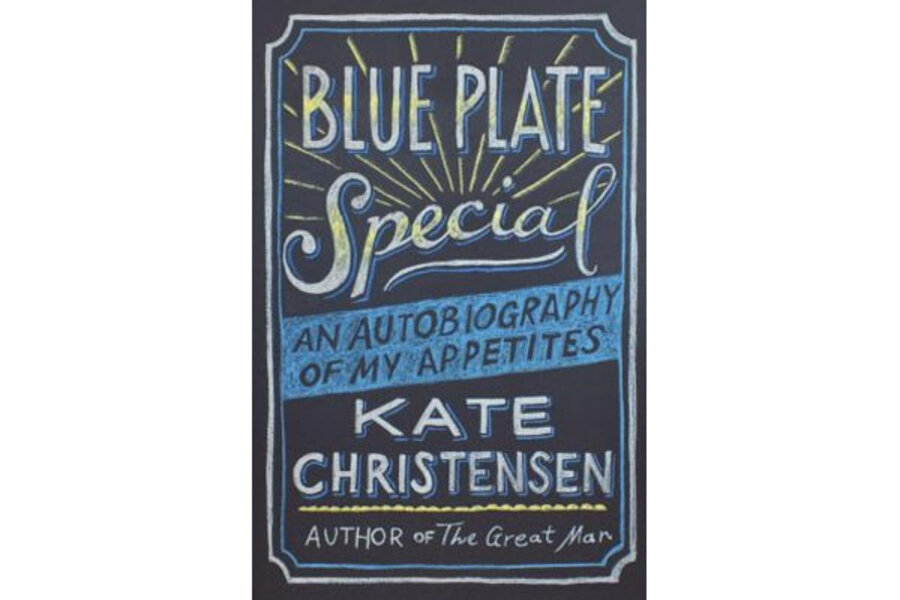Blue Plate Special
Loading...
Novelist Kate Christensen’s memoir, Blue Plate Special: An Autobiography of my Appetites, is a moving feast of memory, a repast of the past. “To taste fully is to live fully,” the author declares at the outset.
Chronicling her American girlhood from the early 1960s (at the end of the Baby Boom), to her present life as a writer and blogger in Maine, the book is an honest portrayal of the forces that have shaped her: love and loss; joy and pain; trust and despondency. In those 50 years, the author turned to food – to nourish away gloom, to celebrate, to reconnect with lost years. The book includes a smattering of recipes: Anadama bread, Yorkshire pudding, rabbit stew, among others.
Originally written as blog posts, the book’s brief chapters read like complete stories in themselves. Christensen, author of seven novels including "The Great Man," winner of the 2008 PEN/Faulkner Award, writes wonderfully. Her clean prose is sprinkled with witty phrases and wry observations.
The story begins at a “wrecked breakfast” in Berkeley, California, where 2-year-old Kate recoils in confused horror, watching her father beat her mother.
Eventually Kate’s mother moves her three daughters to Arizona so she can attend graduate school, and then on to a Bohemian “ghost town” in northern Arizona where the girls are forced, yet again, to fit into all new schools. But the teenaged Christensen isn’t satisfied; she enrolls in a Waldorf-inspired high school in upstate New York, only to discover the rural idyll includes male teachers who take sexual advantage of students while officials turn a blind eye.
Upon graduation, Christensen takes a job as a nanny in France, where she learns French language and cooking (by far the most interesting culinary discussion in the book). Here’s Christensen making her popular muesli for breakfast: “Every night before bed, I cut up all the ripest plums, peaches, and apricots in the larder, and soaked it all in milk overnight with a heap of steel-cut oats. The next morning the vat held a slightly fermented, sticky, thick mass that smelled like library paste on a rotting orchard floor. The … kids couldn’t get enough of it.”
Boyfriends come and go; food obsessions wax and wane; her weight seesaws.
She graduates from Reed College, and in 1987 enrolls in a Masters in Fine Arts program at the prestigious Iowa Writers’ Workshop, a place she calls “terrifying, chilly, and competitive … a man’s world, and a boy’s network.” She encounters teachers helpful – the delightful Allen Gurganus – and hurtful. Director Frank Conroy, she says, dismisses the writing of women students as “little coming-of-age novels,” despite the fact that his own memoir, "Stop Time," was just that. She even wins a short story contest, sponsored by "Mademoiselle" magazine, with a story Conroy had disliked. (A good reminder for budding writers to take your writing teacher’s advice with a shaker of salt!)
Dumped again by a boyfriend, Christensen moves herself to New York, works briefly in publishing, including ghostwriting for a Spanish countess, which becomes the topic of her first novel. “What matters is that you keep writing,” Allen Gurganus had encouraged her at Iowa, when she’d bemoaned a broken heart. So she dives in. During lunch breaks, after work, on weekends: She writes, writes, writes.
“For the first time since junior high … I was writing in my own voice,” Christensen says. “Gone was the earnest Iowa Writers’ Workshop attempt to be Faulkner, to be Great…. Sometimes I felt electric with joy at the words that came from my fingers, but most of the time it was agonizing and terrifying.” It took ten years to finish, and in 1999, during the “chick-lit” wave propelled by Helen Fielding’s "Bridget Jones’ Diary," Christensen published her first novel, "In the Drink."
More books follow, and then a marriage and an adoption (of a rescue dog – a compromise with her husband who doesn’t want to have children).
This latter portion of the memoir, focused on her marriage and writing, seems far more interesting than the earlier portions because the author reveals more of herself – her flaws, her grit and determination. Narrators of memoir tend to be most interesting when they’re at war with themselves; certainly Christensen’s inner conflicts – in her 30s and 40s – make for a more satisfying meal than autobiographical bits that lack complexity.
In fact, the food asides started to feel gimmicky, almost a way for the author to avoid the work of self-reflection. I was left wanting less of the literal, and more of the metaphorical appetite promised in the book’s subtitle – giving us a sort of Italian-meringue icing on this otherwise tasty literary cake.








